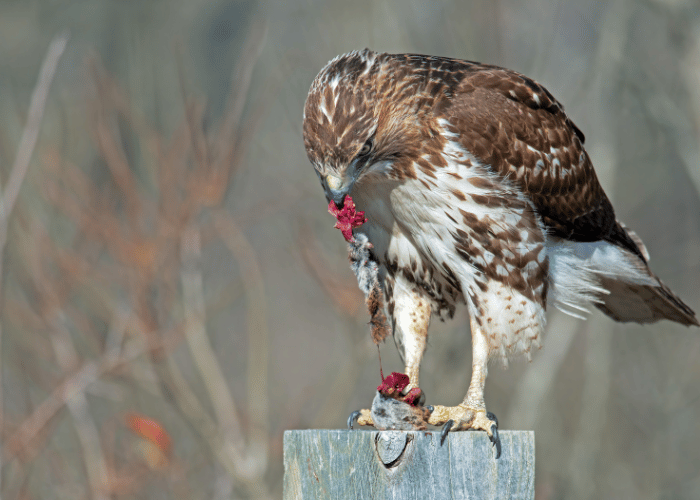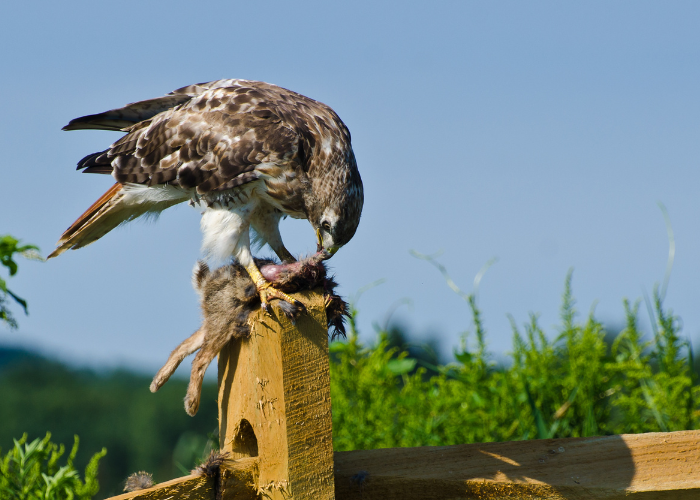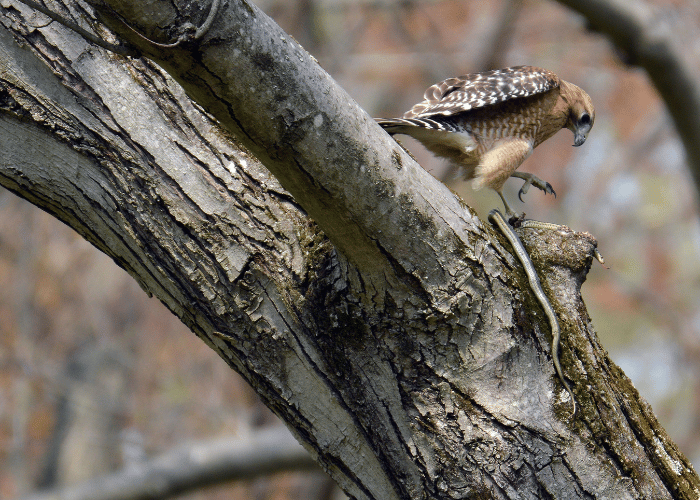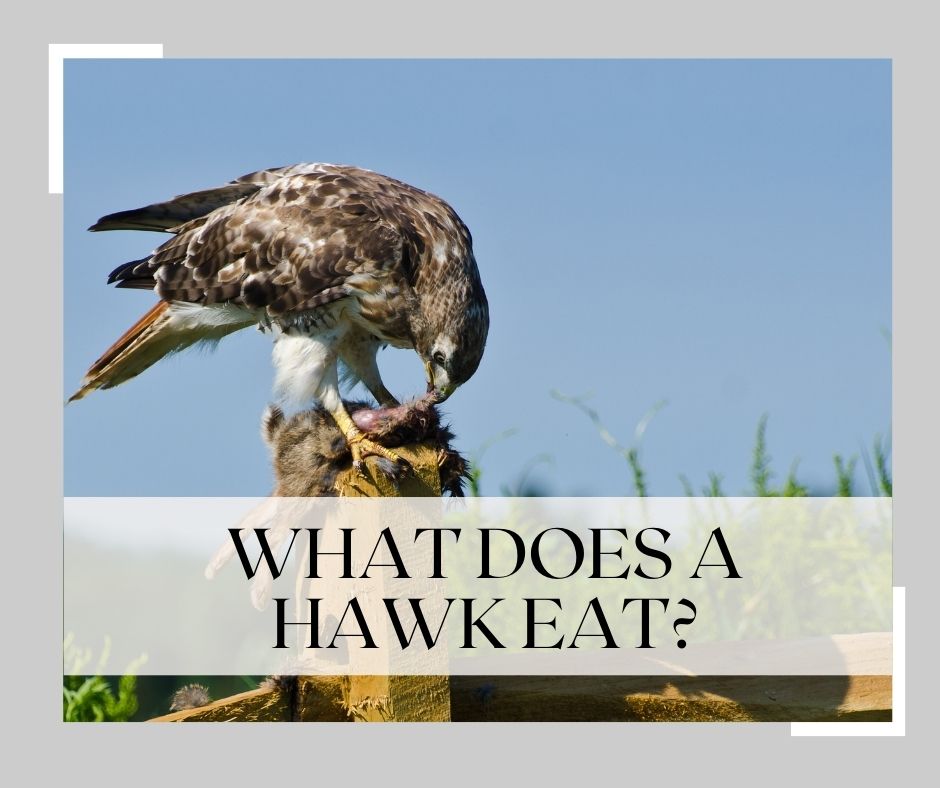What Does a Hawk Eat
Table of Contents
You’ve probably seen a hawk soaring high above, scanning the ground for its next meal. These powerful birds of prey are known for their abilities to spot tiny creatures from striking distances, but what exactly do they eat? Hawks are essentially carnivorous birds, their diets vary depending on their species and the area in which they live.
Predominantly, hawks feast on a variety of small mammals, birds, reptiles and insects. Ever wonder how your area’s squirrel population stays in check? You might just have a hungry hawk to thank! Quite the avid hunters, these predator birds have no qualms about swooping down to snatch a quick rodent snack. Different types of hawks have been known to eat everything from mice and rabbits to snakes and even other smaller birds.
Notably, the diet of a hawk changes with the seasons and the availability of food sources. Insects and birds may constitute a larger proportion of their meals during warmer months, while small mammals become a preferred choice in colder seasons. Understanding this, it’s clear to see that hawks are truly adaptable predators, adjusting their feeding habits based on their environment and available prey. So next time you see a hawk circling the skies, try to guess- what’s on its menu today?

Understanding Hawks: Lifespan and Characteristics
It’s crucial to dig a little into the vital facts about hawks before venturing into the specifics of their diet. Hawks belong to the Accipitridae family, encompassing over 200 species. With such wide diversity, they offer an array of distinct characteristics and behaviors.
These marvelous birds are known for their unparalleled eyesight. Imagine having the ability to spot a mouse from a skyscraper’s height – that’s how powerful a hawk’s vision is. These incredible predators are also renowned for their vast wingspans and nimble flight.
Hawks are fascinating to study due to their range of lifespan. How long they live primarily hinge on their species and environmental conditions. For instance, the Red-Tailed Hawk, one of the most common varieties in North America, can live up to 20 years in the wild.
Here’s a quick look at the lifespan of certain hawk species in the wild:
| Hawk Species | Average Lifespan |
|---|---|
| Red-tailed Hawk | Up to 20 years |
| Cooper’s Hawk | 12 years |
| Sharp-shinned Hawk | 7 years |
While these facts might seem adequate, there’s a great deal more to uncover about hawks. By studying aspects like their lifespan and vital characteristics, you get a clearer image of these raptors’ eating habits and why they prefer certain foods. So next time you spot a hawk hovering in open fields or perching on a tree branch, you’ll know there’s a lot more to these skilled hunters than meets the eye.
The Diverse Diet of a Hawk
When it comes to the dining habits of hawks, you’ll find an array of diverse options on their menu. Hawks are opportunistic hunters, with their diet changing according to their immediate environment. They’re equipped to handle anything from small rodents to reptiles!
Small mammals make up the bulk of their diet. Rodents such as mice, voles, and rats are favorite meals. Hawkeye vision allows them to spot these prey scurrying around on the land below. But they don’t stop at rodents. Have you noticed there’s fewer rabbits in your garden? That could be because they’ve become delicious sustenance for a hawk!
Next up, hawks have quite a taste for birds as well. They’ll often target smaller birds that they can easily overtake. Their skill for aerial hunting is formidable. They can snatch a bird right from the sky in a swoop and clasp it tightly in their talons. Amazing, right?
Not restricting their diet to the land, they’re fond of the aquatic life too. Fish and amphibians often find themselves on the hawk’s dining table. Ever notice a hawk perched near a water body? They’re patiently waiting for an unsuspecting amphibian to venture too far from their safe haven.
Reptiles also make up a portion of a hawk’s diet. Reptiles like snakes and lizards could be the next meal ticket.
Here’s a quick summary:
| Diet Component | Examples |
|---|---|
| Small Mammals | Mice, voles, rats, rabbits |
| Birds | Smaller birds |
| Fish and Amphibians | Fish, frogs, toads |
| Reptiles | Snakes, Lizards |
Picky eaters, hawks are not! Their skill set allows them to adapt to different environments and food sources. So the diverse diet of a hawk? It’s a testament to their skill as potent hunters adapting to their environment, with the capability to switch up their meals with ease. That’s something to respect about these magnificent birds. Though, I mean, no offense to the rodent lovers out there!

How a Hawk’s Hunting Techniques Impact its Diet
The hunting techniques of a hawk have a direct impact on its diet. Hawks are predators. They are known for their excellent eyesight, flying skills, and sharp talons or claws, all of which contribute to their successful hunts.
Mostly, hawks hunt during the day. You’ll find these birds soaring high above, constantly scanning the ground for potential prey. When a hawk spots prey, it swoops down swiftly, catching the unsuspecting victim off guard. Hawks can spot small mammals, reptiles, insects, and even fish, which are vital components of their diet.
Besides mammals, birds are a significant part of a hawk’s diet. Being adaptable hunters, hawks risk a mid-air fight with other birds, highlighting their assertive and relentless nature. Insects, while seemingly insignificant, play a valuable role in their diet, particularly when larger prey is scarce.
Another critical aspect of a hawk’s hunt is its habitat. Hawks are found in varied environments – from deserts to forests, and even in urban settings. The availability of prey in these areas affects their diet significantly.
Here is a small table illustrating the diet diversity of hawks:
| Habitat | Prey |
|---|---|
| Desert | Rodents, snakes, lizards |
| Forest | Birds, squirrels, rabbits |
| Urban Areas | Pigeons, rats, squirrels |
Their versatile diet not just highlights their adaptability but also the necessity of varied prey in their survival. By diving into a hawk’s hunting techniques and prey choices, you get to appreciate nature’s meticulously knit food web. This intricate balance in nature ensures the survival of these majestic creatures, helping them stand strong at the top of the avian food chain.
Factors Influencing a Hawk’s Dietary Choices
Deciding what’s on the menu for a hawk largely depends on a collection of factors. Your location, the time of year, and the specific species of the hawk can all play a fundamental role in narrowing down their food choices.
For a start, let’s talk geographical location. The environment in which a hawk lives provides a specific set of prey animals. Hawks living in forest territories tend to favor eating smaller birds and rodents, while those in desert regions can be seen feasting on reptiles and insects. Moving on to coastal areas, you’ll find that these hawks select fish and small mammals for their meals. See the chart below for a simplified look:
| Hawk’s Location | Likely Prey |
|---|---|
| Forests | Small birds, Rodents |
| Deserts | Reptiles, Insects |
| Coastal | Fish, Small mammals |
Another deciding factor applies to the seasons. hawks’ diets can greatly fluctify throughout the year. In warmer months, you’ll see an uptick in their consumption of insects and reptiles, whereas in colder seasons, they turn to mammals and birds that remain accessible.
Then there are the species-specific dietary patterns. For instance, the Red-tailed Hawks are known for their rodent-centered diets, while the Sharp-shinned hawks often opt for songbirds. Some hawk species, like the Northern Goshawk, do not hold back and may target larger prey such as wild turkeys and rabbits. It’s all about which species of hawk is doing the hunting.
Ultimately, every hawk’s diet is a mixture of several factors. The bird’s geographical location, the time of year, and the specific hawk species are the primary contributors. That’s not to forget other elements such as availability and the energy cost of capturing different types of prey. The varied diet shows just how adaptable these incredible raptors can be.
Environmental Impacts on a Hawk’s Diet
Mother Nature always leaves an indelible mark on every creature’s diet, and indeed, hawks are no different. Weather patterns, the change of seasons, alterations in the terrain, and mankind’s intrusions into natural habitats all add a layer of complexity to the question, “What does a hawk eat?
Primarily, seasonal variations significantly dictate a hawk’s food agenda. during the balmier months, small mammals like mice, squirrels, and rabbits typically form the bulk of a hawk’s diet. You’ll notice an uptick in amphibian and fish consumption when you’re near a river or lake. But as winter’s chill takes hold, it becomes increasingly challenging to locate these prey. Instead, hawks turn towards more accessible sources such as small birds, insects, and even carrion.
Imagine rough terrains and landscapes influencing a hawk’s food choices. A hawk living in dense woodlands or forests have a knack for hunting small mammals and birds, while their cousins residing in wetlands primarily go for fish and amphibians. It’s a game of adaptability, where every ecosystem has its own set of prey and predators.
Now let’s factor in human interferance and its aftereffects on a hawk’s diet. The expansion of urban cities into wild habitats prompts significant changes in hunting habits. Don’t be surprised to find hawks preying on pigeons in cityscapes where skyscrapers have replaced the age-old trees. Similarly, pesticide use in agricultural areas can decrease the number of insects, indirectly affecting the availability of prey for hawks.
To summarize, keep in mind that every hawk’s diet is as diverse as the landscapes they inhabit. Throw in the additional seasonal and human-induced variations, and you’ve opened the door to a world of limitless combinations. The next time you spy a hawk soaring above, remember that you’re not just watching a bird, but a masterful survivor adapting to the whims of a rapidly changing world.

Conclusion: The Fascinating Diet of Hawks
You’ve come a long way and managed to delve into the captivating world of hawks and their diets a moment ago. Hawks, as you’ve come to see, are ravenous eaters with a versatile palate.
They eat a wide variety of foods—including small mammals, birds, reptiles, and even insects—which reflect their adaptability to a breadth of habitats, from cities to deserts and everything in between. Does it intrigue you that a bird of prey like a hawk can down a snake for lunch? It’s a testament to their hunting prowess.
Diet variety in hawks can be somewhat classified according to their species too. Below is a summary table showing three different species of hawks and their preferred sustenance:
| Hawk Species | Preferred Diet |
|---|---|
| Red-tailed Hawk | Rodents, small mammals |
| Sharp-shinned Hawk | Small birds |
| Cooper’s Hawk | Birds, small mammals |
Here are some interesting facts you’ve gathered about the fascinating diet of hawks:
- They need to eat a tenth of their body weight daily
- The physical features of hawks make them excellent hunters
- The beak and talons are their main tools for snagging and devouring their prey
- Hawks have keen eyesight that allows them to spot their food from a great distance
So, how do hawks affect your ecosystem? As you can see, they play a crucial role by helping to regulate populations of rodents and insects. The next time you see a hawk soaring in the sky, you’ll know it’s on a mission for its next meal, playing a key part in the rhythm of nature.
In your journey of understanding what hawks eat, you’ve also discovered the importance of hawks in maintaining ecological balance, haven’t you? The more hawks hunt, the more they contribute to the ecosystem by keeping check on the populations of potential pests.
By knowing what hawks eat, you can better appreciate these majestic creatures and the essential roles they play in our world’s delicate ecological system. It’s clear that hawks, with their diverse diets, are more than just birds of prey; they are nature’s carefully crafted solution to manage and maintain balance in the environment. And that’s the true beauty of understanding the diet of hawks.






